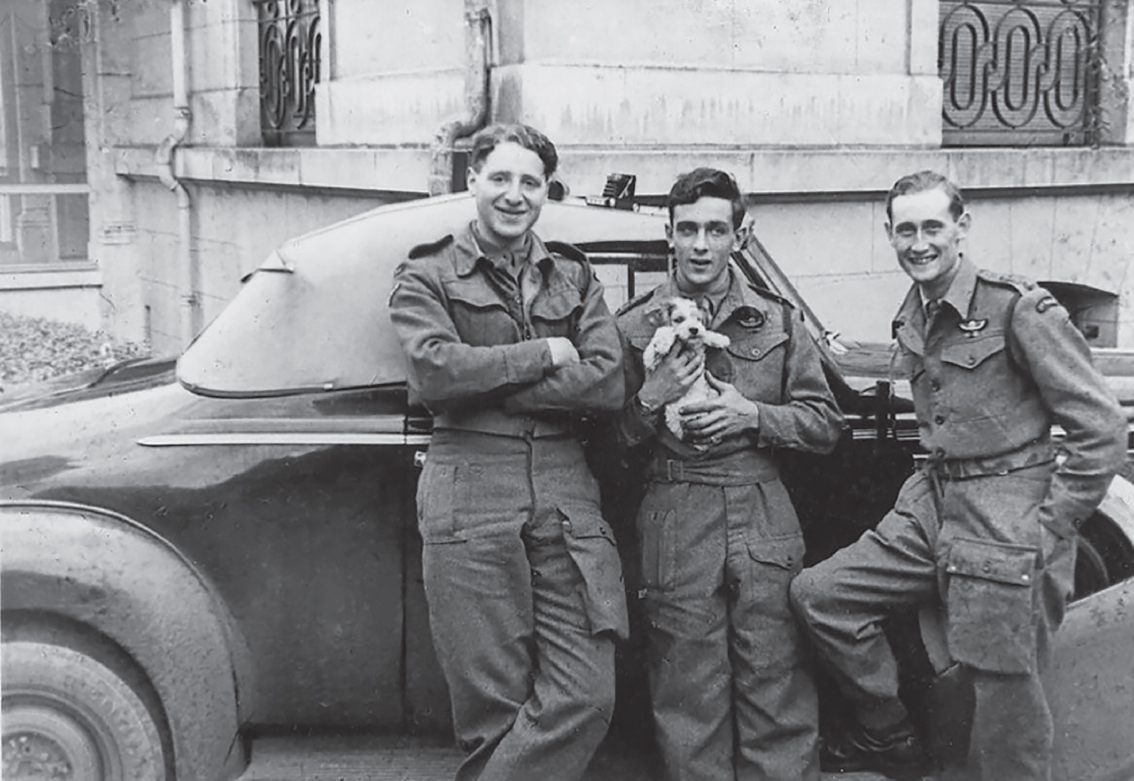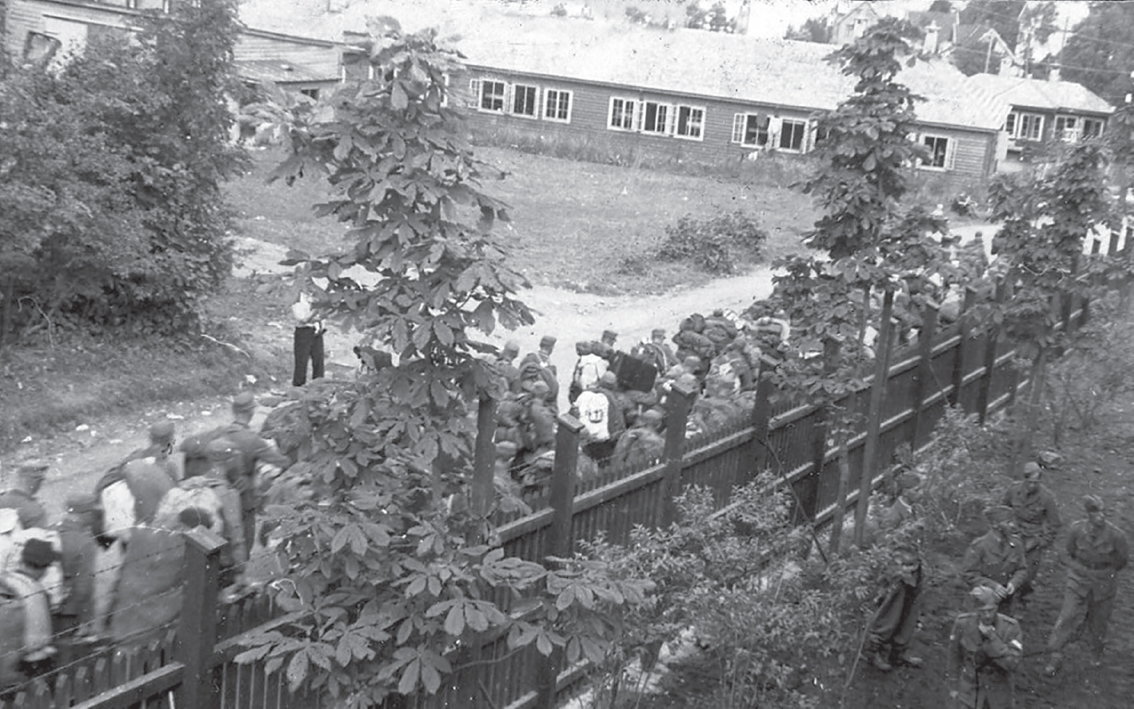Peter Davis returned to England in December 1943 and spent several months undergoing further training.
He embarked on two more operations, and was awarded the MC for the role he played in Operation Kipling (13 August–25 September 1944). Below is his original self-written report, requested by his superiors and reproduced with kind permission of The SAS Regimental Association:
‘29 Aug. Whole of ‘C’ Sqn at FORET DE MERRYVAUX – Capt DAVIS’, Lt BRYCE’s and Sgt MITCHELL’s patrols detailed to attack convoys moving Eastwards along the LA CHARITE-CLAMECY road. Moved off from camp 12.30 hrs. Owing to Sgt STOREY’s jeep overturning, both occupants being injured, the move was much delayed and the party did not really start before 1600 hrs.
Intention was to take the three patrols to a point near the road to be attacked, and then to split up, but owing to the accident, and the fact that Lt BRYCE’s jeep had to remain behind with the injured men, the original 9 jeeps were reduced to 7, and 19 men, and Capt DAVIS decided to make use of three jeeps as one force. Two 3″ mortars were also taken.
Arrived within 5 miles of road without mishap or contact with the enemy, and the remaining 5 miles to the chosen ambush position were made with the guidance of an FFI NCO, who caused much delay through leading the party the wrong way. 1800 hrs, arrived chosen ambush position, which proved unsuitable for jeeps, but excellent for mortars. Two jeeps with mortars were left here, remaining 5 jeeps proceeding to a small wood about 2 miles away, about 4 kms West of the village of NANNAY. Once again the guides lost their way, but eventually we arrived at wood 2230 hrs. Jeeps were concealed in the wood alongside the road, and an uneventful night was passed.
30 August. 0900 hrs 2 mortar jeeps re-joined main body. Still no movement along road, and it was decided to choose another road to attack. At 0930hrs, the jeeps were in the act of being manoeuvred onto the road in preparation for moving off, when the head of a German convoy appeared about 300 yds away. The leading vehicle, a civilian saloon car, together with an enemy section of infantry were immediately engaged by Tpr GRIERSON’s and Tpr PAGAN’s jeeps. After about a minute the enemy returned our fire with two light machine guns, rifle and machine pistols, but their fire was very inaccurate. Leaving these two jeeps to engage the enemy Capt DAVIS took a foot party of 6 men round the left flank, and Sgt MITCHELL did likewise on the right flank. The enemy leading section were in a ditch on the roadside and the left flanking foot party got to a point within 35 yds of them, when a lively S.A. and grenade battle ensued for about 5 minutes. PAGAN’s jeep was then called up the road to spray the ditches, which he did, so effectively that the foot party was able to reach the enemy vehicle – beside it in the ditch we found three dead Germans, two seriously wounded, and one slightly injured. They were disarmed and one LMG, 3 rifles, 1 pistol, and grenades were taken. A Sgt Major (badly wounded) was in command of the section. Their unit was 338 STAMMKOMPANIE.

Belgium, October–November 1944. Ron Grierson, Peter Davis, Derrick Harrison.
The prisoner who professed himself to be a Pole was not more than 18 years old, and extremely scared. He was only too willing to talk. In the car was found an Officer’s map case which was taken and searched. Meanwhile the rest of the enemy column had retired, and beyond occasional sniping it was again quiet – the enemy appeared to be in considerable confusion as grenades and 2″ mortar bombs were seen bursting over half a mile away. It was learnt that the enemy column was about 250 men strong and from their operational order, which was captured in the map-case, it was also learnt that the force consisted of two infantry companies supported by M.G. Section, an A/T section and L.A.A. Section.
We then withdrew, leaving the dead and wounded, having disclosed to the wounded that we were English and the advance guard of a large force. We went back two miles down the road and took up an excellent position on a hill about 300 yds from the road, behind a thick hedge. The mortars were sighted onto the road, 4 jeeps were sited covering the road and 1 jeep (Cpl JONES) was detailed to cover our flank and rear. A very good escape route was provided in the shape of a track leading into the FORET DA DONZY in which there was a maze of tracks. At about midday, LMG and rifle fire was heard in the direction from which we had come. Two civilians on bicycles later came up and told us that the Germans had just fired on them.

Germany, April 1945. Jeeps refitting at Lowp.
We remained in this position until 1915 hrs, when a very large convoy was sighted coming down the road below us, from the direction of LA CHARITE. Estimated 30 vehicles, including 5-ton lorries, civilian cars and scout cars. 3 lorries were towing light 20 mm cannon. The convoy stopped just beneath us, presumably to clear the village NANNAY. We engaged with 12 Vickers for 5 minutes – estimate 4,000 rounds fired. Mortars did not have an officer and only fired three bombs. Enemy reaction was very strong and accurate – within 15 seconds of our opening fire they were replying. Three trucks dropped their side disclosing a 20 mm cannon which immediately went into action, together with heavy 2″ mortar and LMG fire.
Fire was exchanged fiercely for five minutes, during which time 2 large lorries and one civilian car belonging to the enemy were seen to be blazing fiercely; then, noticing that the enemy infantry were making good progress up the hill towards us, and suspecting the presence of enemy scout cars on our flanks, we withdrew to the pre-arranged RV in the centre of the FORET DA DONZY. Five out of the seven jeeps and 14 men met at the RV at approx 1945 hrs. The last jeep was followed by an enemy scout car, which seemed very disinclined to give battle and did not enter the wood. We waited one hour in the centre of the wood for the missing 5 men, but for fear of being surrounded, withdrew towards DONZY under cover of dusk at 2045 hrs. Meanwhile the enemy continued to give battle hotly for 1½ hrs after we had disengaged….
At about 2130 hrs, 3 ambulances arrived to pick up casualties, and made several runs to LA CHARITE. Several sources report that between 30 and 40 of the enemy were killed, and twice that number wounded. The enemy took everything away with them, so an accurate estimate of damage done is impossible. Civilians report that the convoy was composed of 37 vehicles and about 600 men, and the convoy moved back towards LA CHARITE with 15 vehicles in tow. 2 Germans were wounded by their own officers in an attempt to make them fight. The FFI in LA CHARITE reported that the Germans realised that the attack was made by British troops, and there was considerable apprehension in the town that these attacks were the prelude to larger ones. Barricades were created, and similar precautions were taken in LA CHARITE….
12 Sep. A report came through that 18,000 Germans West of the LOIRE were thinking of surrendering. Capt DAVIS assumed the rank of Colonel, with a view to making it easier for the Germans to surrender. (He later resigned this office in favour of Capt BARNBY). Left camp 1800 hrs with 12 jeeps.
13 Sep. Composed a letter in NEVERS to the German commander, to the effect that we had been detailed by General PATTON to take charge of his surrender and to disarm his men. We then crossed the LOIRE and at MORNAY we heard that there was a German column just up the road. Capt DAVIS went forward in a jeep, under a very large white flag, to parley with the German commander, a Lt Colonel. From him, he learned that the 18,000 Germans, under Gen ELSTER, had already surrendered to the Americans, and were to proceed to ORLEANS with all their transport and arms, and under no circumstances were they to give up their arms before their arrival there. We then decided to find General ELSTER and find out from him (a) whether there were any Germans in the area who had not received the order to surrender, and (b) whether there were any Germans, including SS troops, who had refused to surrender. We followed in the tracks of the General as far as Bourges, but were unable to locate him. At BOURGES, Col BOURGOIN, C.O. 4th French Para Bn, requested us to help him to picket the entrances to the town, to prevent any of the surrendering German columns from entering and causing alarm and despondency among the civil population. Jeeps were picketed as instructed, but no enemy seen.
Norway, Bergen, July–August 1945

Germans waiting to be searched.

German columns marching to docks.
14 Sep. The force returned to camp by patrols. Convoys of Germans, who had surrendered, fully armed, were seen at many points. We arrived back in camp and remained there until moving to BRUSSELS.
On account of civilian reports that small parties of Germans with and without arms, and in uniform or civilian clothes, were moving by night in an attempt to escape to Germany, one patrol was sent out each night to form a road-block, and establish the identity of all.’
Captain Davis took part in Operation Howard (6–29 April 1945). Hitler committed suicide on 30 April 1945. Germany was surrendering to the Western Allies and, in these last days of the war, Captain Davis was wounded whilst rounding up surrendering Germans. He later said that he noticed a certain look on a German officer’s face, and realized that this officer was not going to surrender. Fortunately he ducked to his right, the bullet went through his left shoulder, but killed a young German girl who was running across the road behind him.
Captain Davis was in Norway, overseeing the disarmament of 300,000 Germans, when the war ended.